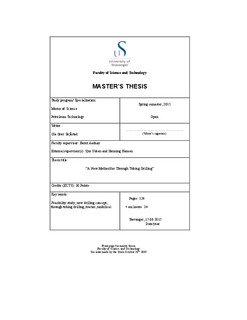| dc.contributor.author | Skjåstad, Ola Grav | |
| dc.date.accessioned | 2015-09-21T13:00:58Z | |
| dc.date.available | 2015-09-21T13:00:58Z | |
| dc.date.issued | 2015-06-15 | |
| dc.identifier.uri | http://hdl.handle.net/11250/300931 | |
| dc.description | Master's thesis in Petroleum engineering | nb_NO |
| dc.description.abstract | As the world energy needs rises, the demand for new oil and gas reserves will increase along with the need for increased recovery from existing reserves. Through tubing drilling is one method of accomplishing increased recovery. New laterals can be drilled from existing wells with the completion in place to access bypassed reservoirs that were too small or too difficult to access due to the additional drilling cost. Through tubing drilling methods can also be used to extend the life of a mature asset by producing another part of the reservoir.
Today, the conventional methods of accomplishing this are coiled tubing drilling or through tubing rotary drilling. Even though these are established methods in the industry, there is room for further development.
This thesis is the start of a feasibility study for a concept called UmbiliDrill. UmbiliDrill is an all-electrical drilling system operated by a spool-able umbilical deployed from the surface. The system has the potential to drill these laterals more safely and cost effectively by being more ac- curate in the placement of the well in the reservoir, having more effective well paths and having the potential for a shorter operational timespan.
The feasibility is determined by evaluating the potential of UmbiliDrill, finding and evaluating available supporting technologies, evaluating how UmbiliDrill will function in an actual operation and evaluating if the system fulfills the design requirements to drill a well with respect to torque, drag, buckling and hydraulics.
The feasibility study revealed that UmbiliDrill has the potential of reducing risk, making it more safe and thereby more cost effective as a through tubing drilling system compared to conventional methods. The study also revealed that it can be an improved system for drilling into difficult bypassed and mature reservoirs. It is not limited by buckling and can always supply enough torque and weight on bit, thus it can drill further and with a more complex well path than con- ventional methods.
A few limitations to the drilling performance were discovered with regards to the hydraulics and hole cleaning and there is some uncertainty of some of the features of the system. However no show stoppers were identified. Based on this, further development of the system is recommended. | nb_NO |
| dc.language.iso | eng | nb_NO |
| dc.publisher | University of Stavanger, Norway | nb_NO |
| dc.relation.ispartofseries | Masteroppgave/UIS-TN-IPT/2015; | |
| dc.rights | Navngivelse 3.0 Norge | * |
| dc.rights.uri | http://creativecommons.org/licenses/by/3.0/no/ | * |
| dc.subject | petroleumsteknologi | nb_NO |
| dc.subject | petroleum engineering | nb_NO |
| dc.subject | boreteknologi | nb_NO |
| dc.title | A new method for through tubing drilling | nb_NO |
| dc.type | Master thesis | nb_NO |
| dc.subject.nsi | VDP::Technology: 500::Rock and petroleum disciplines: 510::Petroleum engineering: 512 | nb_NO |

